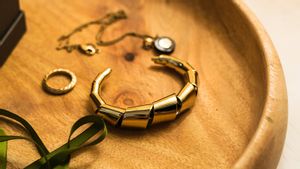Snapshots
Imagine walking down the streets of Lucknow, India, and being greeted by the mesmerising sight of women adorned in ethereal, intricately embroidered sarees that seem to float in the breeze. These sarees are none other than the chikankari sarees, a piece of Indian craftsmanship that has been passed down from generation to generation.
Chikankari is an ancient embroidery technique that dates back to the Mughal era in India. Legend has it that the technique was introduced by Nur Jahan, the wife of Emperor Jahangir, who was fascinated by the delicate and intricate embroidery by the local craftsmen in Lucknow.
The traditional chikankari design was initially embroidered on white cotton fabric using white thread, but the latest chikankari sarees are created with unique fabrics and fun colours. Chikankari embroidery is a labour of love that requires hours of dedication and patience. The intricate and delicate designs are created using a variety of stitches like the backstitch, chain stitch, and satin stitch, resulting in a breathtaking work of art that is both elegant and timeless.
Today, chikankari sarees are not just a part of Indian culture, but also a symbol of India's rich heritage and craftsmanship. The sheer fabric and delicate embroidery make them perfect for weddings, formal events, or a casual day out to add a touch of elegance to your wardrobe.
Let's dive into the specifics, shall we?
What is Chikankari?
The answer to what is chikankari lies in the name itself. The term "Chikankari" refers to a traditional form of embroidery that has its roots in Lucknow, India. The word 'Chikan' translates to embroidery, while 'Kari means work. Chikankari involves delicate and intricate embroidery work on sheer fabrics like cotton, silk, or chiffon, using white thread. The traditional chikankari designs are embroidered using a variety of stitches, resulting in elegant and timeless designs.
How is it made?
Chikankari is made using two techniques: block printing and embroidery work.
Block Printing
The first step is block printing, which involves printing the design onto the fabric using a wooden block. The block is dipped in dye and then pressed onto the fabric to create an outline of the design on the fabric.
Embroidery Work
The second step is embroidery work, which involves using a variety of stitches like backstitch, chain stitch, and satin stitch to fill in the design. The embroidery is usually done by hand, which requires a lot of skill, patience, and dedication.
How can Chikankari be worn in different ways?
Chikankari can be worn in different ways depending on the occasion and personal style. Here are a few ways to wear chikankari:
Saree: Wondering how to wear chikankari sarees to look like an ethereal beauty? Chikankari sarees are perfect for weddings, formal events, or even a casual day out. Pair it with traditional Indian jewellery and simple makeup to complete the look.
Kurti: A chikankari kurta paired with leggings or palazzo pants is perfect for a casual day out or a lunch date.
Dupatta: A chikankari dupatta paired with a plain kurta and jeans or leggings is perfect for a semi-formal event.
Lehenga: A chikankari lehenga paired with a matching blouse and traditional jewellery is perfect for weddings or formal events.
How to style chikankari sarees
Choose the right blouse
The blouse plays a crucial role in the overall look of your latest chikankari sarees. For a classic look, opt for a matching chikankari blouse. If you want to experiment, try a contrasting blouse in a solid colour to make the saree pop.
Keep it simple
The secret of styling chikankari sarees to look like a serene beauty lies in keeping it simple. Chikankari sarees are already rich in intricate embroidery, so it's best to keep the rest of your look simple. Avoid heavy jewellery or accessories that can distract from the saree.
Pair with traditional jewellery
If you want to accessorise, opt for traditional Indian jewellery like jhumkas, bangles, or a necklace. These will complement the chikankari embroidery and add an elegant touch to your overall look.
Opt for a simple hairstyle
A simple hairstyle like a low bun or a side braid can complement the saree without taking away from the intricate embroidery work.
Choose the right footwear
Heels or flats can both work with a chikankari saree, depending on your preference. If you opt for heels, make sure they're comfortable enough to walk in for an extended period.
Play with colours
While chikankari sarees are typically white with white embroidery, you can also find them in other colours like pastels, brights, or even black. Experiment with different colours to find the one that suits you best.
Wear it with confidence
More than how to wear a chikankari saree, the trick lies in how you carry it. The most important thing when wearing a chikankari saree is to wear it with confidence. The intricate embroidery and sheer fabric can make you feel vulnerable, but embrace it and enjoy the elegance and beauty of the traditional Indian garment.
How to wash Chikankari?
Chikankari embroidery is delicate and requires special care when washing. It's best to hand wash chikankari sarees or clothes in cold water with a mild detergent. Avoid using a washing machine or dryer, as it can damage the embroidery. It is also recommended to avoid direct sunlight while drying chikankari.
Lucknow’s chikankari is celebrated as an Indian treasure, not just with celebrities and celebrations in India, but the love for chikankari is spread across our borders too. Many celebrities are often spotted in their favourite airport look piece: a chikankari kurta. Supermodel Gigi Hadid donned a timeless chikankari saree by Abu Jani Sandeep Khosla on her recent visit to India to celebrate the launch of NMACC. Styled with an armour-like blouse, this look has been the talk of the town, and rightly so. Chikankari with a twist done right, spreading the desi girl vibe worldwide!


_1682057572160_thumb_1200.png?w=3840&q=75)

